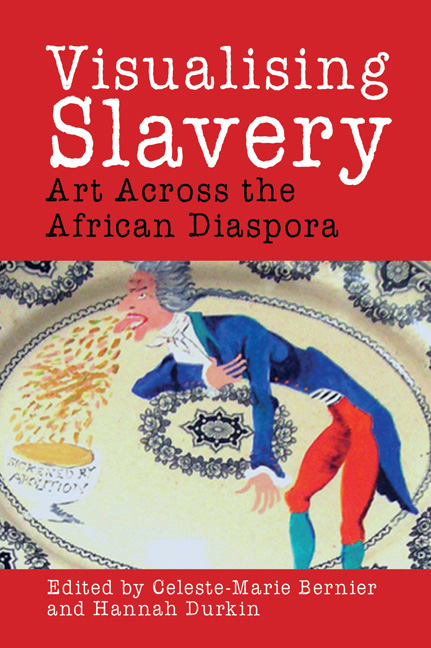Book contents
- Frontmatter
- Dedication
- Contents
- List of Illustrations
- Acknowledgements
- Introduction: ‘Inside the Invisible’: African Diasporic Artists Visualise Transatlantic Slavery
- Part I Slavery and Memory in Contemporary African Diasporic Art
- Part II Historical Iconography and Visualising Transatlantic Slavery
- Chapter 6 The Chattel Record: Visualising the Archive in Diasporan Art
- Chapter 7 Henry Box Brown, African Atlantic Artists and Radical Interventions
- Chapter 8 Uncle Tom and the Problem of ‘Soft’ Resistance to Slavery
- Chapter 9 The After-Image: Frederick Douglass in Visual Culture
- Part III African Diasporic Monuments and Memorialisation
- Part IV Contemporary Legacies in African Diasporic Art
- Afterword: Against the Grain: Contingency and Found Objects
- Notes on Contributors
- Index
- Platesection
Chapter 7 - Henry Box Brown, African Atlantic Artists and Radical Interventions
from Part II - Historical Iconography and Visualising Transatlantic Slavery
- Frontmatter
- Dedication
- Contents
- List of Illustrations
- Acknowledgements
- Introduction: ‘Inside the Invisible’: African Diasporic Artists Visualise Transatlantic Slavery
- Part I Slavery and Memory in Contemporary African Diasporic Art
- Part II Historical Iconography and Visualising Transatlantic Slavery
- Chapter 6 The Chattel Record: Visualising the Archive in Diasporan Art
- Chapter 7 Henry Box Brown, African Atlantic Artists and Radical Interventions
- Chapter 8 Uncle Tom and the Problem of ‘Soft’ Resistance to Slavery
- Chapter 9 The After-Image: Frederick Douglass in Visual Culture
- Part III African Diasporic Monuments and Memorialisation
- Part IV Contemporary Legacies in African Diasporic Art
- Afterword: Against the Grain: Contingency and Found Objects
- Notes on Contributors
- Index
- Platesection
Summary
It is 1849, you are a Southern US functionary in charge of the penitentiary in Richmond, Virginia and you have to enumerate your prisoners, divide them into Black and white, make sure the register tallies and accurately document a novel and idiosyncratic crime to sit alongside the others:
3/1 For murder in the second degree
3/0 For slave stealing
1/0 For aiding slaves to abscond
5/1 For larceny
13/3 For forgery
1/1 For bigamy
1/0 For arson
1/0 For barn burning
1/0 For highway robbery
1/0 For having a ½ dollar die to counterfeit with
1/0 For enticing slaves to be boxed up.
In the twenty-first century, this factual record of a novel form of slave fugitivity is now in the archives and survives as a powerful testament to the bureaucratic discourse of the Southern US slave power. It is recorded as a specific form of criminality with its own row in the column. We might speculate with Dionne Brand as to the way such a functionary would undertake his account keeping. She describes how:
In this museum are records, books, lists, names of the enslaved and their age, sex and physical condition … I look down each list, I try to imagine someone writing these lists. Would they have written them down … [contemporaneously] … or would they have kept a running record? Would they have had a cup of tea before going to the job or would they have stopped in the middle, gone home to have an afternoon nap, and returned thinking what a nuisance paperwork was? Or would this person have written the [facts and figures] quite happily with a flourish in the wrist, congratulating himself or herself [on the completion of the task]?
The task is to leave a complete record without blemish. The task of the prison guard/plantation owner/slave ship captain/archivist is to make the enumeration everyday, ordinary, so as to dispel any doubt that this is normality. Brand's description of the workaday nature of agents within the panoptical control of the ‘peculiar institution’ of slavery articulates the archive's powerful message of a controlled world to which there is no alternative. As Stephanie Smallwood reminds us, such business narratives are often the only evidence we have of individuals who lived everyday lives in the slave system:
- Type
- Chapter
- Information
- Visualising SlaveryArt Across the African Diaspora, pp. 104 - 118Publisher: Liverpool University PressPrint publication year: 2016

